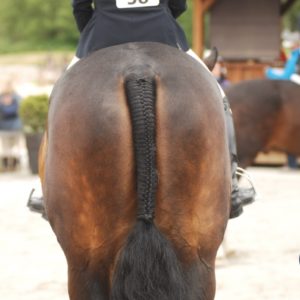I have such mixed emotions about this one! I began training in the day that thoroughbreds were being used less and less, and warmbloods started being used far more often on the show circuit and in lesson programs.
As a trainer, I can’t really say I taught a ton of people to ride on thoroughbreds—although I owned and showed my share of great ones. I learned to ride solely on thoroughbreds and ponies, and I wouldn’t have changed my background in riding at all. The thoroughbred brain is like no other, and their hearts are bigger than most. Because of that, they can be easily scared and messed up in the wrong hands.
The warmblood, in general, is way slower-thinking and less reactive. For sure, you have your few that are more sensitive, and witty, but that’s not the breed standard like it is with thoroughbreds. To learn to ride thoroughbreds, you must have a great trainer and listen well to keep them at their best. Which usually makes for more talented riders overall.
That’s because the margin for error is less with a thoroughbred—you must learn to ride well. Warmbloods, on the other hand, are more tolerant of errors, which I feel makes for a better lesson mount. But it can also create more bad riding, too. Personally, I think some people need a taste of that high standard that thoroughbreds used to require of riders again.
There is so much controversy with this subject, as it’s really a preference in your teaching thought process. For me, the breed is always secondary to the brain and the heart of a horse—and I’d much rather have the brain and the heart over talent. But for some, talent is the biggest thing. It would be great if more people would choose to buy horses for the right reasons, and not for talent or ‘the look’ of the sport!
For me, it comes down to who I am teaching and what their expectations are to know which horse is best for them. I wish we had more thoroughbreds to try and bring up to make great again in the hunter ring, which would also create an avenue where maybe prices could be more reasonable overall. But I also know how important the warmblood is to the training programs of many instructors, so I can see both sides of this issue.
From a judge’s point of view, I love a beautiful, great-jumping thoroughbred, but I don’t like to pin a skinny, fast, bad-jumping horse at all. Safety for the rider is #1 when I’m judging. So, if you have that one-in-a-million, great-style thoroughbred, I’m all-in for awarding the top ribbon I can give. But I would for sure rather see the slow, thick, quiet-tempered warmblood walk into the ring vs. an underweight, leg-hanging, running-down-the-lines thoroughbred—which, unfortunately, we do see a lot.
I think a ‘bad-style’ warmblood is usually better than a ‘bad-style’ thoroughbred, which is in-part why the thoroughbred got a bad rap in the hunter ring. If a horse in my ring jumps great, and goes soft and relaxed, it could be a zebra—I don’t care! As a judge, the pedigree doesn’t matter to me. I care about the whole picture: athleticism, beauty, connection, softness, rideability—that’s what I am judging. And, in terms of the safety piece, that’s also the kind of horse that makes the best teacher for adults and children.
As a mom, I think the safer horses are usually warmbloods, so I tend to lean toward that breed. But truthfully, it is all about what makes the best teacher for my kid. If a thoroughbred can teach him or her more, then I am all for it. Individual horses have different brains, needs, and desires‚ and we must rely on the best option for our kids to learn on, not a specific breed.
Dana Hart Callanan is a successful hunter, jumper and equitation coach, an ‘R’ judge, and a sales broker. In this column, she answers common questions about A level sport. Send your questions to news@horsenetwork.com for consideration in a future column.




 March 18, 2024
March 18, 2024 






















